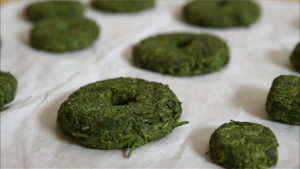Doncha facts for kids
| Cheongtaejeon tea.jpg | |
| Type: | Post-fermented tea |
|
|
|
| Other names: |
|
| Origin: | Korea |
|
|
|
| Quick description: | Coin-shaped post-fermented tea |
|
|
|
| Temperature: | 85–95 °C (185–203 °F) |
| Time: | 5‒10 minutes |
| Korean name | |
| Hangul |
돈차
|
|---|---|
| Hanja |
-茶
|
| Revised Romanization | doncha |
| McCune–Reischauer | tonch'a |
| IPA | [ton.tɕʰa] |
Quick facts for kids Alternative name |
|
| Hangul |
전차
|
| Hanja |
錢茶
|
| Revised Romanization | jeoncha |
| McCune–Reischauer | chŏnch'a |
| IPA | [tɕʌn.tɕʰa] |
| Alternative name | |
| Hangul |
청태전
|
| Hanja |
靑苔錢
|
| Revised Romanization | cheongtaejeon |
| McCune–Reischauer | ch'ŏngt'aejŏn |
| IPA | [tɕʰʌŋ.tʰɛ.dʑʌn] |
Doncha (돈차; lit. "money tea") is a special kind of tea from Korea. It's also called jeoncha (전차; 錢茶; lit. "money tea"). This tea is shaped like a coin, which is how it got its name! Doncha is a post-fermented tea, meaning it goes through a special aging process. In the Jangheung area of South Jeolla Province, it's known as cheongtae-jeon (청태전; 靑苔錢; lit. "green moss coin").
Contents
The Story of Doncha Tea
Doncha tea has a very long history. It began way back during the time of the Later Silla kingdom in Korea. A famous temple called Borimsa was important in its early days. The Jangheung region, where the temple is located, was a major center for Korean tea culture. This was especially true during the Goryeo and Joseon dynasties. Many of the main tea-making places in Korea were found right there.
How Doncha Tea is Made
Making Doncha tea is a careful process. It starts in May when tea leaves are picked by hand. These leaves come from wild tea plants growing along the southern coast of the Korean peninsula.
Unlike many other Korean teas that are roasted, Doncha leaves are steamed. About twelve hours after being picked, the leaves are steamed in a gamasot, which is a traditional cauldron.
After steaming, the leaves are pounded. This is done using a jeolgu (a traditional mortar) or a maetdol (a traditional millstone). Then, the tea is shaped into round lumps and left to dry in the sun.
Once the tea lumps are dry, a hole is made in the center of each one. This gives them their special coin-like shape, similar to old Korean coins called yeopjeon. This is where the name "money tea" comes from!
Finally, the tea is fermented. It ages for at least six months, which helps it develop a richer taste and smell. Sometimes, this fermentation can last for over twenty years!
Preparing Your Doncha Tea
To make a cup of Doncha tea, you usually use one lump. This lump is about 7–9 grams (0.25–0.32 oz) in weight. You can steep it in about 500–600 millilitres (18–21 imp fl oz; 17–20 US fl oz) of hot water. Let it steep for five to ten minutes.
Sometimes, people gently roast the tea lump on both sides over low heat before brewing. Roasting helps to clean the tea leaves. It also helps to create a special smell and taste. Doncha tea is great because it keeps its flavor even after you steep it three or four times!
Doncha in Traditional Medicine
In traditional Korean medicine, Doncha tea was believed to have several helpful qualities. People thought it could help with mild issues like stomach aches. It was also thought to help the body cleanse itself. Some believed it could help reduce fever and prevent constipation. It was even used to help manage symptoms of the common cold.


